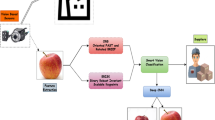Abstract
We describe a novel system for grading oranges into three quality bands, according to their surface characteristics. The system is designed to process fruit with a wide range of size (55–100 mm), shape (spherical to highly eccentric), surface coloration and defect markings. This application requires both high throughput (5–10 oranges per second) and complex pattern recognition. The grading is achieved by simultaneously imaging each item of fruit from six orthogonal directions as it is propelled through an inspection chamber. In order to achieve the required throughput, the system contains state-of-the-art processing hardware, a novel mechanical design, and three separate algorithmic components. One of the key improvements in this system is a method for recognising the point of stem attachment (the calyx) so that it can be distinguished from defects. A neural network classifier on rotation invariant transformations (Zernike moments) is used to recognise the radial colour variation that is shown to be a reliable signature of the stem region. The succession of oranges processed by the machine constitute a pipeline, so time saved in the processing of defect free oranges is used to provide additional time for other oranges. Initial results are presented from a performance analysis of this system.
Similar content being viewed by others
References
Davenel, A., Guizard, C.H., Labarre, T. & Sevila, F. (1988). Automatic Detection of Surface Defects on Fruit Using a Vision System. J. Aric. Engng. Res.: 1–9.
Duda, R. O. & Hart, P.E. (1973). Pattern Classification and Scene Analysis. Wiley-Interscience.
Grasso, G. & Recce, M. (1996). Scene Analysis for an Orange Picking Robot. In Proc. of 6 th Inter. Congress for Computer Technology in Agriculture, 275–280. VIAS.
Hush, D. R. & Horne, B. G. (1993). Progress in Supervised Neural Networks – What's New Since Lippmann? IEEE Signal Processing: 8–39.
Khotanzad, A. & Hong, Y. H. (1990). Invariant Image Recognition by Zernike Moments. IEEE Trans. Pattern Analysis and Machine Intelligence: 489–497.
Maeda, H. (1987). Grade and Colour Sorter Through Image Processing. In Proc. of Intern. Symp. on Agric. Machinery and Intern. Coop. in High Tech. Era, 350–356. University of Tokyo.
Maudit, N., Duranton, M., Gobert, J. & Sirat, J. A. (1992). Lneuro 1.0: A Piece of Hardware Lego for Building Neural Network Systems. IEEE Trans. Neural Networks: 414–422.
Rumelhart, D. E., Hinton, G. E. & Williams, R. J. (1986). Learning Internal Representations by Back-Propagating Errors. Nature 323: 533–536.
Shearer, S.A. & Payne, F.A. (1988). Color and Defect Sorting of Bell Peppers Using a Machine Vision System. Trans. ASAE: 1–9.
Tillett, R.D. (1991). Image Analysis for Agricultural Processes: A Review of Potential Opportunities. J. Aric. Engng Res.: 247–258.
Werbos, P. J. (1974). Beyond Regression: New Tools for Prediction and Analysis in the Behavioral Sciences. PhD thesis, Harvard University.
Author information
Authors and Affiliations
Rights and permissions
About this article
Cite this article
Recce, M., Plebe, A., Tropiano, G. et al. Video Grading of Oranges in Real-Time. Artificial Intelligence Review 12, 117–136 (1998). https://doi.org/10.1023/A:1006596507181
Issue Date:
DOI: https://doi.org/10.1023/A:1006596507181




